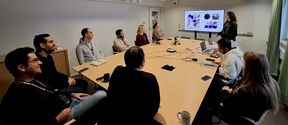What are doctoral studies like?
As a doctoral student, you are part of an international academic community. The doctoral research and studies develop you into an expert of your research topic and build your professional capacity.

Emilia Kauppi interrupted her career in industry to return to Aalto University to work on a doctoral dissertation. She is part of the Sereplas project at the Bioinnovation Center, which is looking for more efficient ways to recycle liquid packaging board. Partner companies Valmet and Stora Enso are closely involved in the project.
Kauppi had already been thinking about doing a doctoral dissertation when she got her master's degree in 2012. She had originally studied paper and printing technology, but she also became interested in inorganic chemistry, which was her minor subject, and her master's thesis was about ALD thin films.
‘But I wanted to know what it would be like to work in the corporate world,’ she says. ‘I ended up working in several companies in the semiconductor industry, such as Murata, and at the laser manufacturer nLIGHT. In my work I met many people with PhDs and realised that they had the kind of deep skills and knowledge that I also wanted to have.’
In the spring of 2023, Kauppi wrote to a professor who she knew with some thoughts about a dissertation project. The professor happened to know a colleague who was launching a project for which Kauppi's skills and board knowledge were ideally suitable, Kauppi had done well in her earlier studies.
‘I’ve learned more in smaller companies, where there’s more freedom to experiment. For example, at nLIGHT I couldn’t just read standards from a guidebook. I was also free to engage in development work and research.’
Now, Kauppi is doing research to find new and more efficient ways to recycle liquid packaging board containing both wood fibre and plastic. Today, fibre and plastic from containers for liquids are separated, but the plastic is incinerated to produce energy, though a lot of valuable fibre remains stuck to it. This is especially wasteful because liquid packaging materials have to use clean, high quality fibres.
Kauppi finds it inspiring to work on a topic that she considers extremely important. ‘It’s good to do meaningful work on something important. It’s also motivating to work with professionals in the field and to learn from them. We’re studying how the fibre sticks to the plastic and how they can be detached from each other using as little energy as possible. It is both a challenge and a dilemma not to break the plastic.’
Kauppi’s work is being supervised by Professor Jouni Paltakari, the head of the project, and funding is coming from the collaborative corporate partners Valmet and Stora Enso, as well as the Aalto University Bioinnovation Center.
Throughout his 20-year career as a professor, Paltakari has worked on different types of packaging board and their coatings. In the early part of his career, printing paper was the forestry industry’s most important product, but the situation has changed.
‘Sereplas puts us at the core of the matter. The role of packaging is underscored in the growth of online sales and in the food industry. A thorough knowledge of the carbon footprint of packaging is important, and EU directives guide recycling and the reduction of emissions. These regulations are becoming more stringent, and companies want to prepare for changes before it’s too late. Students are also very enlightened and even worried about these issues,’ says Pallakari.
Valmet sees Sereplas as part of the extensive Beyond Circularity programme, a collaboration of over 130 partners in which Valmet serves as a leading company. In addition to universities and research institutes, the partners include customers such as Stora Enso, as well as subcontractors.
‘The goal of the Beyond Circularity programme is to create sustainable growth and to support the green transition in the customers’ fields by converting waste and emissions into valuable resources. All of the business areas at Valmet are involved. Sereplas has especially close links with our paper business, and it is part of the collaboration in which Aalto is involved. Stora Enso has its own ReMatCh research project included in the programme,’ says Valmet Ecosystem Director Virpi Puhakka.
Puhakka describes how research can serve as a glue to link parallel projects from different partners. Searching for common interests begins at an early stage.
‘We had discussions with Jouni Paltakari and Stora Enso on what the research point of view is and what questions interest both Stora Enso and the university. When the big picture had been clarified, Jouni was able to search for a person with suitable skills and knowledge, as well as an interest in the topic.’
Puhakka emphasises that companies are also actively involved in the ongoing research.
‘Instead of producing scientific research that is just filed away, Stora Enso's materials, our pilot possibilities, and the university's research laboratories are used extensively. The companies have a hands-on involvement here, and there’s close collaboration with Emilia and Jouni as well as the research teams of Stora Enso and Valmet.’
The research laboratory for the doctoral work is in Aalto’s Bioinnovation Center, which specialises in new opportunities for the bioeconomy, especially bio-based packaging and textiles. The launch of the Bioinnovation Center was made possible by a contribution of EUR 10.5 million from the Jane & Aatos Erkko Foundation.
‘Many of the subprojects in Sereplas involve collaboration with mechanical engineering. All these projects have an interdisciplinary approach, including technology, chemistry, and materials science,’ says Paltakari.
Kauppi's four-year doctoral work was launched in the summer of 2023. In her lab work, she’s been testing an extensive range of options for separating the fibres and plastic. ‘It’s been very unrestricted. I’ve been able to pursue whatever I felt was good, and the communication with Valmet and Stora Enso has worked fine. They’ve been interested in all aspects of the results, and they constantly ask what happened in the testing,’ Kauppi says.
The next step in the research is small-scale piloting. The challenges grow as the project moves toward industrial applications. Paltakari says the problems can’t be solved by academic research alone but work on a doctoral dissertation is opening new perspectives.
‘Research is like a funnel. The harsh reality is that when thinking about a factory, possibilities for scaling and the desire to invest in new equipment technologies must be considered. As economics gets closely involved, solutions also have to be examined from a life cycle analysis point of view. The costs of operating industrially are on a completely different scale than research funding.’
Kauppi hasn’t yet decided whether she will aim for a career in research or if she’ll go back to the corporate world after completing her dissertation. ‘The world of research may be closer to my heart, but I’d love to somehow combine research with a corporate career. I hope the professional skills that I’ve amassed would enable me to pass on my in-depth expertise.’
Text: Heidi Hammarsten

As a doctoral student, you are part of an international academic community. The doctoral research and studies develop you into an expert of your research topic and build your professional capacity.

Find out what is required of applicants and what can our doctoral studies offer!

